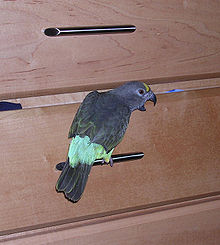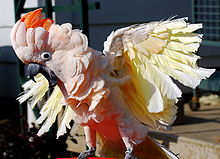- Wing clipping
-
Wing clipping is the process of trimming a bird's primary flight feathers ("primaries") so that it is no longer fully flighted.
Contents
Technique
Wing clipping is usually performed by avian veterinarians, pet store employees, breeders, or the birds' owners themselves. It is generally carried out on pet birds, particularly parrots. It is quite distinct from pinioning, which is carried out by amputation of the wing at the carpal joint. Most birds can regain their flying abilities after wing-clipping if they are allowed to re-grow their feathers. While clipping is endorsed by some avian veterinarians, other avian veterinarians oppose it.[1]
The purpose of wing-clipping is to reduce or prevent a bird's ability to fly. This is seen as a means of preventing it from escaping by flight if it ends up outdoors and increasing its pet potential.
Techniques for clipping the wings vary primarily in the number of feathers cut and the amount of each feather left behind. A mild clip on one wing only can impair a bird's flight greatly, as it renders the bird unbalanced in the air. This can cause injury or death to the bird if it strikes a hard surface during a fall. In most cases, it is only the primary flight feathers that are cut, and an equal number of feathers are trimmed on each wing to avoid causing the bird to become unbalanced in flight. The most common clip involves trimming the primary flight feathers below the level of the primary coverts (usually removing about 1/2 to 1/3 of the length of the flight feather). This clip is quick and simple to do, but leaves exposed cut ends that occasionally may cause a bird to chew on the cut feathers. Another method of clipping involves cutting the flight feather above the level of the coverts, so almost the entire feather is removed. This clip does not leave any exposed cut ends, but as more of each feather is removed, fewer feathers should be cut. However, these cut feather stumps are still present and may irritate the bird, causing significant discomfort.
Where parrots have clipped primary feathers, the moulting sequence of these birds (Juniper and Parr, 1998) renders them vulnerable to damage of their growing blood feathers. Most parrots have 10 primary feathers, numbered 1 (innermost) to 10 (outermost). The moult starts by the bird shedding and replacing a central primary feather, usually number 6 (Glendell 2007). The sequence continues in both directions along the primaries, so the last primary feathers to be replaced are the innermost and the outermost ones numbered 1 and 10 respectively. Clipped birds therefore have their first blood feathers growing down without the normal protection of full-length feathers lying next to them. These unprotected blood feathers are vulnerable to being broken and profuse bleeding can occur.[2] Most parrots, regardless of their size replace their feathers by a daily growth rate of 3 to 4 mm (Glendell 2007) Thus, large species such as macaws may take over a year to complete a moult, but smaller species such as cockatiels will moult within a few weeks. So, larger birds, and those with a higher wing-loading, remain vulnerable to blood feather damage for a longer period, since they are moulting almost continually.
A 'light' symmetrical wing-clip will allow a bird to fly down and land safely while indoors. However such a clip may not prevent the bird from flying when outdoors, since lift is generated in proportion to wind speed. Many escaped birds which are recovered, are found to have been clipped. So, while a light clip allows downward flight indoors, it does not prevent a bird gaining lift if it should escape outdoors. Conversely, a more severe clip will certainly render a bird flightless, but it increases the risk of injury if the bird falls and hits a hard surface. In addition to the physical effects of wing-clipping, there can be adverse behavioural effects. Birds use flight as an instinctive reflex action and as their first means of escaping any threat: they take to the air to fly upwards and away from the source of the threat; their fear then dissipates. Where this behaviour is prevented by wing-clipping, this innate reflex action is denied the bird, and its fear will not subside. This may cause behavioural problems for the afflicted bird [3] When a bird needs to reduce its speed during flight, it employs a 'reverse thrust' action by extending its wing at the wrist joint and using the drag of its primaries as air brakes.[4] While the reduced function of the clipped bird's primaries prevent propulsion and therefore lift, this also reduces braking abilies, so clipped birds may crash-land at higher speeds than full-winged birds.
By restricting flight, wing clipping may help prevent indoor birds from risking injury from ceiling fans or flying into large windows. But there is no evidence to show that clipped birds are safer than full-winged ones, only that clipped birds are subject to different kinds of accidents than full-winged birds.[5] Social pet birds (such as parrots) may also be clipped both to restrict independence and in attempts to make them tamer and easier to manage in order to encourage them to socialize with their owners. Some parrots that show aggression to certain people or other birds may be clipped to prevent attack. However, birds can be trained to accept flight requests or 'commands' and this removes the need for wing-clipping (Glendell 2007). Clipped birds should not be taken outdoors unrestrained, as even clipped birds have been known to fly away when spooked outdoors.
It is generally considered very important for a young bird to be allowed to fledge (learn to fly) properly, prior to any wing clipping. Breeders and owners usually find that a fledged bird, even after being clipped, will remain more confident and active than an unfledged bird. Learning to fly also helps a bird learn how to land safely, an important skill even in clipped birds.
Some people feel wing clipping is a cruel or unhealthy practice as it denies a bird its most natural way of getting around, obtaining exercise and avoiding fearful situations. Although clipped birds can and should be encouraged to do wing flapping exercises, this does not provide the same exercise as flight. Others feel that for birds that can climb well, wing clipping is a necessary safety practice for birds in many situations. The practice seems more prevalent in American bird care books (Athan 1999;[6][7] than in similar British publications.[8][9]
Controversy
 A wing clipped Meyer's Parrot perching on a draw handle, possibly unable to fly to a more comfortable perch.
A wing clipped Meyer's Parrot perching on a draw handle, possibly unable to fly to a more comfortable perch.
Opponents to wing clipping make the following arguments against the practice:
- Pet birds that cannot climb well, including finches, doves, most softbills, and some handicapped parrots generally should never be clipped, as clipping reduces their mobility too much.
- While clipped birds are less likely to fly out open doors or windows or into surfaces, they are more prone to some other household dangers, such as being stepped on or being injured by other household pets.
- Most flighted parrots can easily learn to avoid windows and mirrors in the home. However, for the first few times a parrot flies in a new place, windows should be covered or made more visible.
- Most pet bird species are highly adapted to flight. Some species may fly miles a day searching for food in the wild. Flying is the best form of exercise for birds. Denying pet birds the opportunity to fly may also contribute to sedentary behavior, obesity and related health problems.
- Clipped birds sometimes appear insecure and less confident, perhaps from their inability to escape from perceived predators. Over-clipped birds may have balance problems and fall easily, contributing to insecure or fearful behavior.
- Clipped birds may be more likely to break a bloodfeather on the wing, as new and growing bloodfeathers do not have full length feathers next to them to provide support. Broken bloodfeathers can cause significant blood loss. Pulling broken feathers (sometimes necessary to stop bleeding) is painful, and can cause permanent damage to the feather follicle.
- It is very easy for an inexperienced groomer to overclip a bird. Birds that have not been clipped properly and have had their wings trimmed too short may not be able to land safely. Over-clipped birds can be badly injured if they fall from a perch or attempt to fly.
- With some simple training, most tame flighted birds can be as easy to handle as clipped birds.
- Wing clipping may create a false sense of security. Clipped birds, if spooked, are still capable of a short, powerful burst of flight.
- With the exception of the kakapo, all parrots are flying creatures; they have no behavioural repertoire to cope with flightlessness. Where a bird's ability to carry out its reflex escape response is thwarted by being clipped, it may develop behavioural problems associated with fear. The default position of leaving the bird with the ability to fly normally, while teaching the bird flight commands should ensure safe flying for pet birds.
Advocates note that a properly done clip only trims the feathers and not the wings themselves, and is painless and temporary, lasting only until the next molt. Many owners choose to clip a bird's wings initially while taming it, and then allow it flight with the next molt. Some owners may also choose to just clip enough to slow their bird down, without preventing flight.
Whether or not one clips their birds' wings is an individual decision. Both choices may have risks. While both 'properly' clipped and full-flighted birds are capable of living long lives as pets, birds encouraged to exercise by flying may be more fit than clipped birds.
See also
References
- ^ N Forbes FRCVS in Cage and Aviary Birds, 17th July 2008
- ^ Manual of Psittacine Birds, Peter H Beynon 1996
- ^ Veterinary Times, 18th Feb 2008. Whose a Naughty Parrot Then; G Glendell W
- ^ Gill FB, Ornithology 2007.
- ^ Low R, A Guide to Grey Parrots. ABK 2006.
- ^ Athan M_S Guide to a Well-behaved Parrot, 1999.
- ^ Rach 1998, Rach, J Why does my Bird Do that?
- ^ Low,R The Loving Care of Pet Parrots 1999
- ^ Glendell, G Breaking Bad Habits in Parrots 2007
External links
Categories:
Wikimedia Foundation. 2010.


